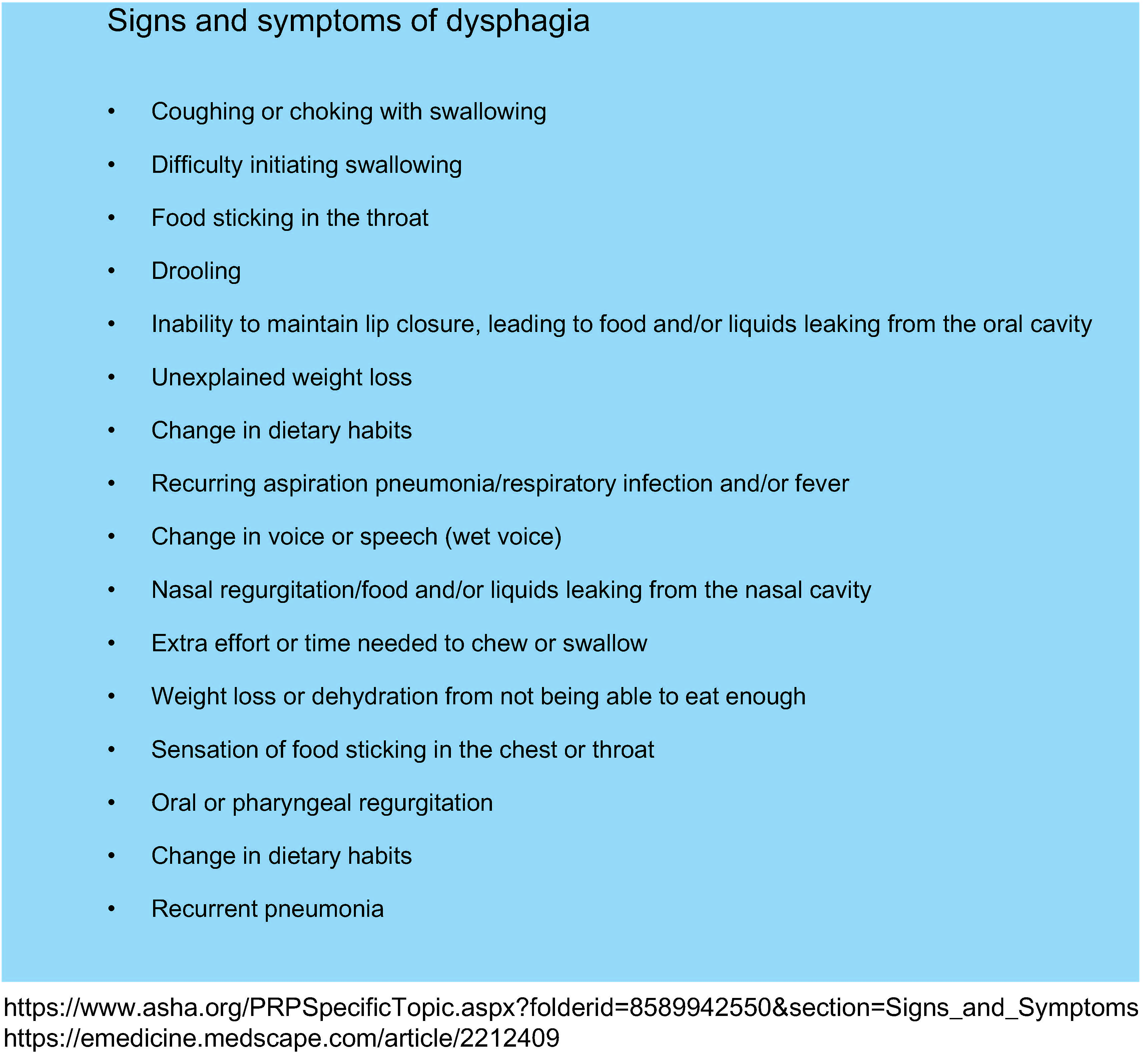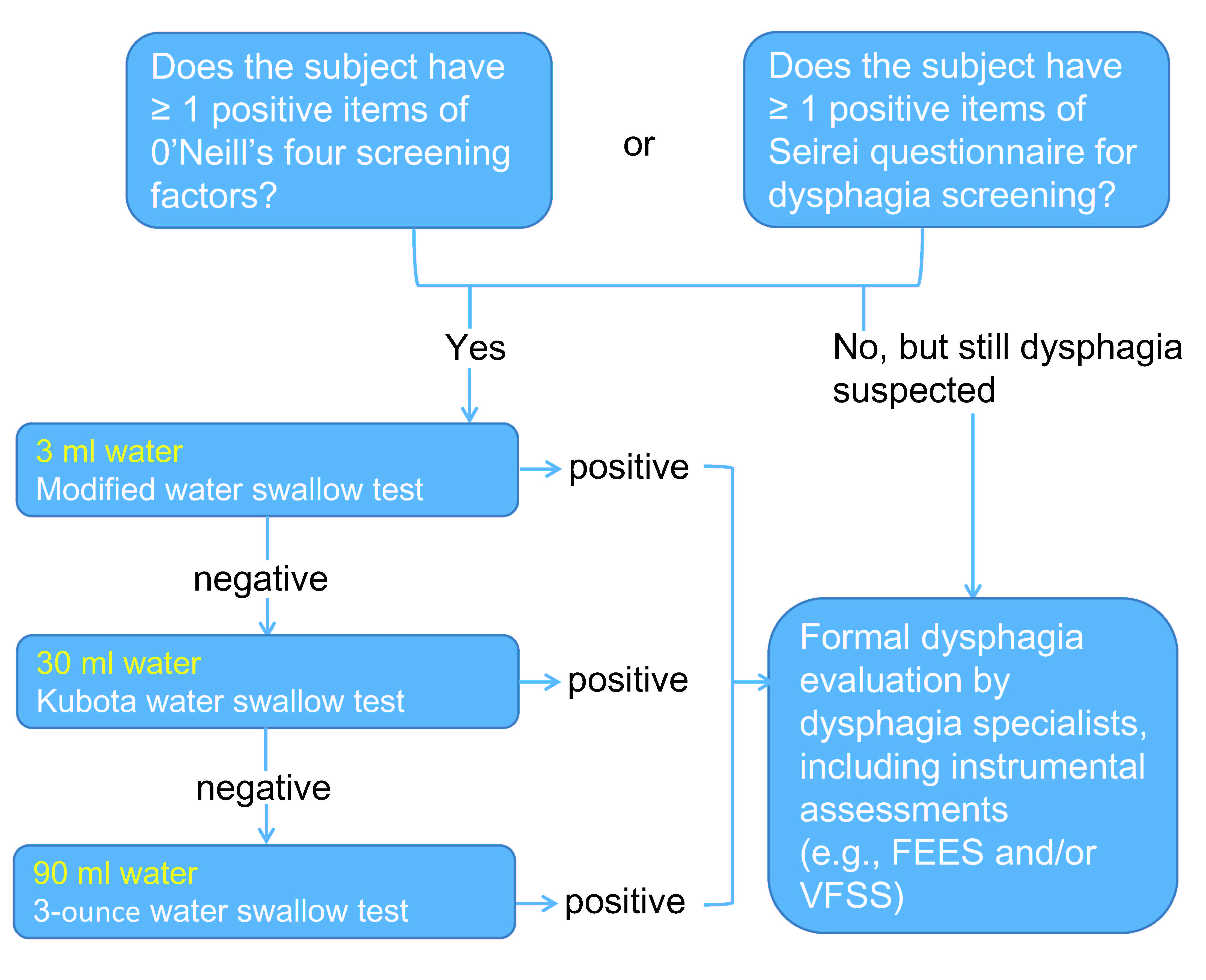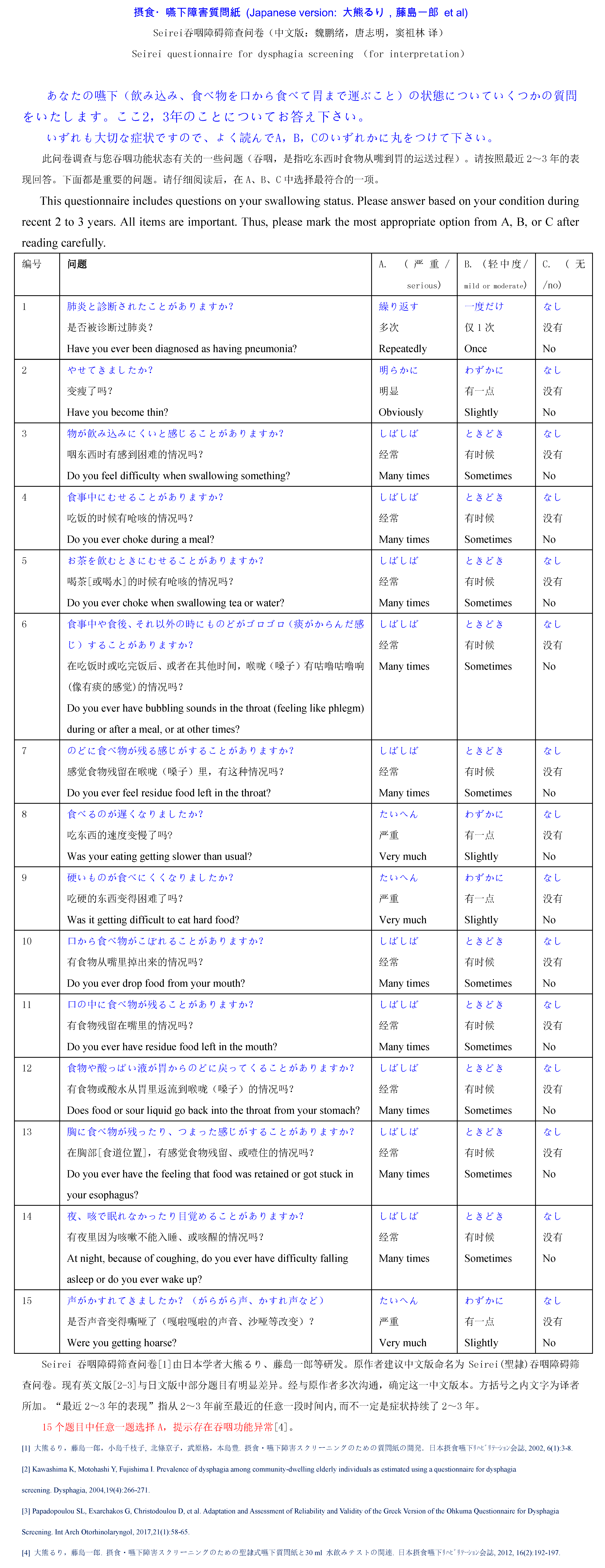Dysphagia is often unrecognized because many people are unfamiliar with symptoms and signs of dysphagia besides choking during swallowing. Dysphagia screening is therefore important. A good screening should be a quick process and minimally invasive but can determine the likelihood of dysphagia. Here, an algorithm for dysphagia screening is introduced. The algorithm can be used for people unspecialized in dysphagia.
- Dysphagia
- Screening
- Algorithm
1. Introduction
Pengxu Wei
Dysphagia, or difficulty swallowing, may result in acute asphyxia (airway obstruction) [1], aspiration pneumonia, dehydration, and malnutrition [2]. Dysphagia has been reported in 8.1-80 % of stroke patients, 11-81 % of Parkinson's disease, and 91.7 % of patients with community-acquired pneumonia [3]. The prevalence of difficulty swallowing in the community-dwelling elderly may be up to 72% [2]. However, dysphagia is often unrecognized because many people are unfamiliar with symptoms and signs of dysphagia (Figure 1) besides choking during swallowing. For nonprofessionals, many of these symptoms and signs are not easily recognized to be associated with dysphagia. Dysphagia screening is therefore important.
Figure 1. Signs and symptoms of dysphagia
2. Influence and application
A good screening should be a quick process and minimally invasive but can determine the likelihood of dysphagia [4]. Here, an algorithm for dysphagia screening is introduced (Figure 2). The algorithm can be used for people unspecialized in dysphagia, e.g., public health practitioners, nurses, or family physicians who have not received the specific training of diagnosing and treating swallowing disorders.
Figure 2. Algorithm for dysphagia screening
This algorithm is a battery of tests applied to screen dysphagia. Each of these tests is simple to learn and use, does not need professional equipment, and does not take much time to perform.
The algorithm includes an initial evaluation of the likelihood of dysphagia including several screening factors introduced by 0'Neill [5] and the Ohkuma Questionnaire [6][7][8] (Figure 3), and then several sequential water swallow tests including the Modified water swallow test (3 ml), Kubota water swallowing test (30 ml), and 3-ounce water swallow test (approximate 90 ml) [9][10]. Tests with increased volumes of water become more challenging to swallowing ability and therefore are more sensitive. For example, a subject with mild dysphagia may pass the 3 ml water swallow test but fail in the 3-ounce water swallow test.
The most useful factors pointing towards high risks of aspiration include: (1) any disturbance of conscious level; (2) wet voice; (3) weak voluntary cough; (4) cough on drinking small volumes of water; and (5) a timed water swallowing test [5].
For each of the water swallowing tests ( 3 ml, 30 ml, and 90 ml), failed to swallow with choking, changes in breathing, presenting post-swallow wet-hoarse voice, holding water in the mouth while drinking, water coming out of the mouth, and throat clearing during or shortly after drinking are positive findings. The 3 ml water swallowing test should be repeated 3 times if the examinee does not demonstrate abnormal signs, and the worst assessment is used as the final result. The 30 ml water swallowing test or 3-ounce water swallow test is performed only once. It is considered abnormal if a subject cannot complete drinking 30 ml water at normal temperature from a cup within 5 s or cannot drink 3-ounce water from a cup without interruption [9][10].
Positive findings indicate the necessity for a formal dysphagia evaluation including a flexible endoscopic evaluation of swallowing (FEES) and/or videofluorographic swallowing study (VFSS). FEES and VFSS are considered gold-standard procedures to diagnose dysphagia [11].
Figure 3. Questionnaire for dysphagia screening.
References
- Samuels R, Chadwick DD. Predictors of asphyxiation risk in adults with intellectual disabilities and dysphagia. J Intellect Disabil Res. 2006. 50(Pt 5): 362-70.
- Madhavan A, LaGorio LA, Crary MA, Dahl WJ, Carnaby GD. Prevalence of and Risk Factors for Dysphagia in the Community Dwelling Elderly: A Systematic Review. J Nutr Health Aging. 2016. 20(8): 806-815.
- Takizawa C, Gemmell E, Kenworthy J, Speyer R. A Systematic Review of the Prevalence of Oropharyngeal Dysphagia in Stroke, Parkinson's Disease, Alzheimer's Disease, Head Injury, and Pneumonia. Dysphagia. 2016. 31(3): 434-41.
- Donovan NJ, Daniels SK, Edmiaston J, et al. Dysphagia screening: state of the art: invitational conference proceeding from the State-of-the-Art Nursing Symposium, International Stroke Conference 2012. Stroke. 2013. 44(4): e24-31.
- O'Neill PA. Swallowing and prevention of complications. Br Med Bull. 2000. 56(2): 457-65.
- Ohkuma R FI, Kojima C HK, Takehara I MY. Development of a questionnaire to screen dysphagia. Jpn J Dysphagia Rehabil. 2002. 6: 3–8.
- Kawashima K, Motohashi Y, Fujishima I. Prevalence of dysphagia among community-dwelling elderly individuals as estimated using a questionnaire for dysphagia screening. Dysphagia. 2004. 19(4): 266-71.
- Papadopoulou SL, Exarchakos G, Christodoulou D, Theodorou S, Beris A, Ploumis A. Adaptation and Assessment of Reliability and Validity of the Greek Version of the Ohkuma Questionnaire for Dysphagia Screening. Int Arch Otorhinolaryngol. 2017. 21(1): 58-65.
- Suiter DM, Leder SB. Clinical utility of the 3-ounce water swallow test. Dysphagia. 2008. 23(3): 244-50.
- DePippo KL, Holas MA, Reding MJ. Validation of the 3-oz water swallow test for aspiration following stroke. Arch Neurol. 1992. 49(12): 1259-61.
- Smith Hammond CA, Goldstein LB, Horner RD, et al. Predicting aspiration in patients with ischemic stroke: comparison of clinical signs and aerodynamic measures of voluntary cough. Chest. 2009. 135(3): 769-777.



